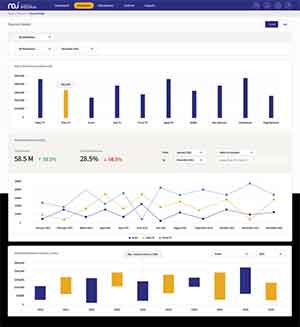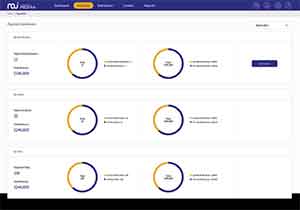Be first to read the latest tech news, Industry Leader's Insights, and CIO interviews of medium and large enterprises exclusively from Media & Entertainment Tech Outlook
THANK YOU FOR SUBSCRIBING
Symphony MediaAI
Leading Critical Breakthroughs in M&E Revenue Operations
 Mark Moeder, CEO
Mark Moeder, CEO The vast majority of M&E businesses today lack the resources to navigate such a fragmented data ecosystem. Consumer tastes vary from moment to moment. They want more content and fewer subscriptions. Pay TV providers and MVPDs are moving toward direct-to-consumer (D2C) streaming; SVOD providers are expanding ad-supported services. In an effort to keep pace, organizations often launch new services faster than they can develop the data capabilities to optimize them.
Mark Moeder, CEO of Symphony MediaAI, plans to change the game. “Companies are not equipped to adapt as quickly as the industry is moving underneath them, and, more importantly, as quickly as consumers are changing their behaviors,” he observes. His solution? “I don't want to solve symptoms; I want to solve root causes, and I want to help our customers transform.”
Thirty Years of Data
In its 30-year history, Symphony MediaAI has been at the forefront of the industry’s data challenges. Moeder says that its genesis was “to help content owners maximize revenue and create distributor accountability through audits.” The company earned a reputation for quality, eventually growing to serve 90 percent of the U.S. M&E industry.
Fast forward to the digital revolution, and Symphony MediaAI—then known as Media Audits International—saw the need for automated data analysis at scale. In 2019, it was acquired by the operating company SymphonyAI (shortly before Moeder joined as CEO). “With SymphonyAI’s vision of democratizing data through the use of AI and us being plugged in with our media partners at a financial level, it was a great opportunity to bring new products to market,” Moeder says.
Having spent a number of years at Google and serving as the chief operating office of an adtech company, Moeder was eager to tackle industry challenges from a content perspective: “Things were evolving quickly with the advent of OTT and all its various incarnations. But no one was really investing to solve the problems inherent with operating in that new model. Being able to drive transformation and help the content side of the industry catch up was really compelling to me.”
Today, Symphony MediaAI is leading critical breakthroughs in revenue operations with its SaaS platform, Revedia. “We have channeled our decades of experience and technical knowledge into a single platform that delivers unprecedented data insight,” says Moeder.
Simplifying Data Complexity
At its core, Revedia is a revenue management and data analysis platform that helps organizations optimize revenue. It aggregates and interprets a range of data including distribution agreements, audit reports, payments, and audience behavior.
Whereas M&E organizations traditionally relied on multiple tools to analyze revenue data, Revedia automates analysis without sacrificing quality of insight. The platform extracts the most valuable intelligence from data that businesses already have, along with the streams of new data being continuously produced. By presenting insight in the form of visual reports, predictions, and prescriptive recommendations, Revedia makes it more actionable to stakeholders.
So-called “citizen data science” is key to Revedia’s value; thanks to the platform’s user-friendly design, business users can generate insight without relying on overburdened experts. “Within minutes, Revedia can answer questions and generate predictions that could take a week for an expert to analyze,” Moeder explains. “It’s one of the most powerful things that we can do for this industry.”
Another aspect that sets Revedia a cut above the rest is the fact that it is revenue-agnostic.
We’ve channeled our decades of experience and technical knowledge into a single platform that delivers unprecedented data insight
Making Sense of Ad-Supported Models
Just two years after Moeder joined Symphony MediaAI, the industry experienced a significant shift. “The Covid pandemic changed the ballgame,” recalls Moeder. “To my mind, it greatly accelerated the evolution of OTT. With the explosion of new platforms, everyone is competing for the same eyeballs.” The resulting increase in customer churn called subscription-based models into question. “That churn made business models very hard to predict,” says Moeder.

Increasingly, the industry is embracing ad-supported models such as FAST and AVOD to compensate for subscription revenue loss. In some cases, Moeder explains, “you're actually netting higher revenues with ad-supported models, depending upon your content library, viewer engagement, your recommendations, strengths, things like that.”
Those dependencies complicate the picture for content providers. Moreover, new licensing terms, ad insertion technologies, and distribution platforms bring about more complex data. Developing an AVOD revenue strategy requires sophisticated data analysis.
Predicting Content and Customer Performance
In addition to the variety of ad-supported options now on the market, the sheer abundance of available content gives viewers few reasons to stay loyal. “With the explosion of new OTT players, subscriber churn exploded along with it,” notes Moeder. “You have people watching for a month, canceling, moving to another platform for a month, and so on. Now it's not just about subscriber acquisition; it's about customer lifetime value in a recurring charge model.”
Organizations that can accurately predict content performance and customer engagement are gaining a significant advantage. “They can be much more agile, much more nimble, and much more profitable,” as Moeder puts it. “Seeing how a given title is performing, what its engagement is, how long people are watching it, all of these factors help inform advertising, content acquisition and distribution strategies.”
The Revedia platform’s predictive insight capabilities are designed to do just that. Organizations maximize ROI by leveraging Revedia’s forecasting tools to optimize content licensing, distribution, and even pricing. Recently, a Symphony MediaAI client migrated data for over 100,000 titles to Revedia. “Within a day, they knew how their content was performing, how they could modify content groupings to maximize partner revenue, and how to improve their content recommendation engine to better engage viewers,” Moeder says.
On the consumer side, Revedia is helping major service providers improve marketing ROI and mitigate churn. Its AI algorithms are capable of predicting customer churn with over 95% accuracy, and detecting anomalies that threaten revenue. Moeder recounts one notable success: “Our AI engine discovered an anomaly in a major OTT player’s data. A segment of customers had signed up for a free promotion years ago but it never expired. So, you had thousands of viewers consuming content free of charge, sometimes daily.”
Automation Takes Hold
Industry executives who recognize the value of data-driven insight are frustrated by the disjointed, manual processes involved in obtaining it; nearly 60 percent are currently prioritizing automation. “Now more than ever, the importance and the frequency of data are paramount,” Moeder remarks. “A lot of media organizations are turning to back-office automation for better, faster insights from the data they already have. And they’re trying to supplement that data with additional sources for a more holistic view of the business.”

Understanding a fickle customer’s changing preferences, a distribution partner’s revenue potential, or a promotional offer’s effectiveness involves rigorous analysis. Automation enables organizations to synthesize high-volume data scattered across internal and external sources. The Revedia platform enables users to automatically search distribution agreements, calculate royalties, log financial transactions, and perform a multitude of daily tasks.
In fact, Symphony MediaAI clients are improving efficiency two-to-threefold by switching to Revedia. The benefits span multiple business domains, from finance to compliance to content licensing.
A Problem-Solving Mind-Set Breeds Success
It’s no accident that Revedia is built to improve collaboration among diverse stakeholders. Moeder describes himself as “a very collaborative person by nature.” Collaboration is further evident in Symphony MediaAI’s approach to client partnerships. Moeder explains: “I know the media industry but that doesn't mean I know a client’s specific business. I want to learn from you as much as you want to derive value from our solutions. What drives you? What can we solve for mechanically and strategically? Most critically, what do you want to know about your business?”
Once Symphony MediaAI has identified a client’s KPIs and success criteria, implementation can be customized to meet their needs—or “tweaking the engine,” as Moeder describes it. “At the end of the day, clients get a somewhat bespoke solution that is creating value for their business.”
The company’s deep expertise in data science, as well as M&E, eliminates the hassle of new technology adoption. “I'm a firm believer that a technologist should understand the ‘why’ behind what they’re building so they can actually improve the product,” says Moeder.
Preparing for the Future of Media and Entertainment
After 30 years in business, Symphony MediaAI has a unique inside perspective on where the industry is headed. “Certainly we have a holistic view of media and entertainment,” Moeder acknowledges. “And with that, we can see not just trends, but predictions on where things will go.” He recognizes that the company has been “very fortunate” to have earned the trust of the majority of North American Media companies. “But the problems we’re solving here aren’t restricted to North America.” Symphony MediaAI is entering what Moeder describes as “a significant phase of investment for geographical expansion, and a significant investment in the Revedia platform to support the needs of media organizations worldwide.”
Symphony MediaAI is further invested in enhancing its data capabilities. In addition to content owner and distributor data, the wealth of third-party data available today, such as social media, can reveal lucrative revenue opportunities. Breaking news about a beloved actor often triggers an uptick in searches of their films; local weather events correlate to interest in natural disaster content. Organizations that automate the process of detecting trends can respond to, and even predict, rapidly changing market conditions. This, notes Moeder, “gives them the insight to engage their customers, make distribution decisions, and optimize revenue in real time.”
Moeder’s final prediction? Symphony MediaAI will continue to deliver greater value to its client partners through powerful, data-driven insight. “Understanding data critically, in an actionable way, will help our customers defend their own interests and their own growth from their own competition,” he says. “Ultimately, the goal is to create value for our customers.”
Copyright © 2025 Media and Entertainment Tech Outlook. All rights reserved | Sitemap | About Us 


